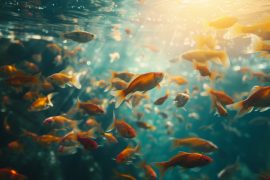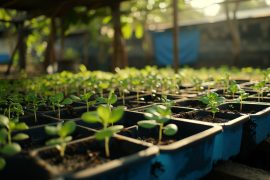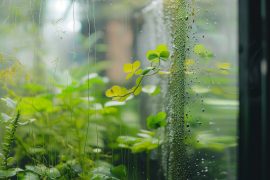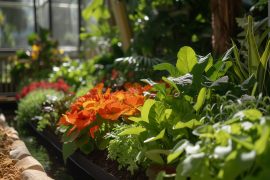As I wander through my lush green oasis, I can’t help but marvel at the symphony of life thriving in my backyard. It’s my aquaponics system at work, a sustainable gardening method that’s as ingenious as it is eco-friendly.
I’ve always been passionate about tending to my garden, but learning about aquaponics opened my eyes to a whole new level of harmony with nature. It’s not just about growing plants; it’s about conserving our most precious resource: water.
Let me take you on a journey through the basics of aquaponics—how it works, why it’s a game-changer for water conservation, and how it might just be the future of gardening. Trust me, it’s a story worth diving into.
How Aquaponics Works
I’ve always believed that to truly understand something, you need to delve into how it operates at its core. Let’s talk about aquaponics. For me, it’s more than just a cultivation method; it’s about forging a peaceful companionship with nature.
Imagine the serene hum of water circulating in your own garden space – that’s the heartbeat of an aquaponic system. Fish and plants live in a symbiotic relationship; as the fish enjoy swimming in their tank, their waste provides an organic food source for the plants.
Here’s the technical bit, broken down simply. The process kicks off with the fish excreting waste into the water they’re swimming in. Rather than becoming harmful, that waste, full of nitrogen, is gold for the plants. With a little bit of microbe magic – bacteria to be precise – this waste is converted into nitrates, an essential nutrient that plants crave.
As the water cycles through the connected grow beds, the plants greedily soak up these nutrients. What happens next is truly the marvel of the system: the water, now stripped of excess waste, flows back to the fish tank clean and clear. It’s a closed-loop system, mimicking earth’s natural cycles, and it’s beautiful in its simplicity.
When I first stumbled upon aquaponics, it was during a tour of a sustainable living fair. I saw a small system operating with such fluidity that it felt like somber poetry in motion. The verdant greens and the silver flashes of fish in the water spoke of a partnership that was almost too good to be true. And yet, there it was, working flawlessly.
To illustrate, let’s consider a straightforward setup:
- A fish tank housing tilapia or carp
- A grow bed where leafy greens and herbs flourish
- A pump transferring water between the two
- Beneficial bacteria thriving in the grow beds, transforming waste to plant food
The beauty of aquaponics is in its versatility. Whether you have a vast backyard or a small urban balcony, this method adapts. It allows you to connect with the gentle rhythm of growing, the susurrus of water, and the dance of fish providing for their green companions.
Understanding the Water Conservation Challenge
As someone who’s spent countless hours getting their hands dirty, I know the tranquil satisfaction that comes with gardening. It’s more than just nurturing plants; it’s a deep dive into nature’s harmony. However, amidst this serenity lies a critical issue—water conservation. Let’s talk about this for a bit.
Water’s crucial for life on this planet, right? Well, in the realm of gardening, it’s our elixir. But here’s the snag—we’re running short on it. Not to throw a wet blanket on our green thumbs but with increasing urbanization and climate shifts, our water sources are feeling the squeeze. Traditional soil-based gardening can be a thirsty business, often requiring more water than you’d think. In fact, studies have shown that agriculture accounts for about 70% of global water withdrawal. That’s massive!
Here’s where aquaponics dances onto the scene. This technique’s not just slick for saving space; it’s a poster child for water efficiency. The closed-loop system recycles water between fish and plants, drastically reducing the need for fresh water. Picture this—you’re giving your plants a drink, and it’s the same water that’s been naturally filtered by your leafy friends and used to house your fish. We’re talking a reduction in water usage by up to 90% compared to conventional gardening. Look at the difference:
| Gardening Method | Water Usage Reduction |
|---|---|
| Conventional Gardening | 0% |
| Aquaponics | Up to 90% |
By now, you might be seeing why I’m all about aquaponics. It’s genius, right? You’ve got a self-sustaining cycle where the only water loss is through transpiration and a bit of evaporation. And don’t get me started on how you don’t need to worry about runoff polluting our streams and rivers. It’s a clean, self-contained cycle.
The Role of Aquaponics In Water Conservation
As I delve deeper into the heart of sustainable gardening, I’ve come to appreciate the rhythmic ebb and flow of aquaponics, a dance of harmony between fish and plants. It’s a tranquil world where I’m deeply connected to the quiet cycles of life and nurturing. Let me walk you through the wonders of this water-conserving marvel.
Aquaponics: A Symphony in Symbiosis
Aquaponics isn’t just about saving water; it’s about creating a miniature ecosystem. Here’s how it works. Fish produce waste, which, in a typical aquarium, would be a problem. But in an aquaponics system, it’s pure gold. You see, the waste contains ammonia, which, with the help of naturally occurring bacteria, gets converted into nitrates. These nitrates then act as a natural fertilizer for the plants. In turn, the plants cleanse the water, which cycles back to the fish. Seems complex? It’s simpler than you might think and incredibly water-efficient.
No Drop Wasted
In my years of tending gardens, I’ve learned that conventional methods can be surprisingly wasteful. Soil gardening often requires a hefty amount of water just to keep the ground moist. Here’s an eye-opener: aquaponics systems can save a staggering 90% more water compared to soil gardens. Here’s why:
| Traditional Soil Gardening | Aquaponics System | Water Savings |
|---|---|---|
| Regular watering needed | Closed-loop system | High |
| Evaporation losses | Minimal evaporation | Reduced |
| Water runoff | No runoff | Eliminated |
Every drop of water that I pour into my aquaponics system continues to work for me, endlessly recycled, and minimizing my environmental footprint.
Benefits of Aquaponics over Traditional Gardening Methods
When I meander through my aquaponics greenhouse, it’s like walking into a tranquil bubble where the harmony of nature thrives in every corner. There’s a sense of peace that envelops me, gently reminding me of the countless benefits this system offers over traditional gardening. Let me take you through a few that particularly stand out.
Water Efficiency has got to be at the top of the list. It’s no secret I’m a water conservation advocate, and it’s astounding to see how aquaponics champions this cause. Traditional gardening practically guzzles water, but here in my aquaponics setup, every drop is used to its fullest potential. Plus, the water here is in constant motion, traveling from the fish tank to the plant beds and back again, and there’s something incredibly reaffirming about being part of this endless life cycle.
The next point is almost a blessing for people like me who aren’t a fan of getting their hands too dirty—Low Maintenance. Forget about the incessant weeding, the battling against pests, or the back-breaking soil tilling. Here, the plants pretty much take care of themselves once the system’s all set up. The fish do the fertilizing, and the plants do the cleaning. It’s a perfect partnership where I get to be more of a spectator than a heavy lifter.
Talking about partnerships, the Ecosystem in Itself nature of aquaponics cannot be overstressed. It’s like hosting a miniature world where plants and fish support one another. It’s educational and a bit magical to bear witness to this symbiotic relationship. While soil-based gardens are ecosystems too, they’re often more susceptible to external variables that can disrupt the balance—something that’s much more controlled in an aquaponic environment.
And if you’re a techie like me, aquaponics offers a playground to fiddle with. The Technical Ingenuity required can seem daunting at first, but it’s another area where this method shines. With a bit of research and some trial and error, I’ve learned to manage the water pH, nutrient levels, and the flow rates, all of which are essential in keeping my green friends happy.
The Future of Gardening: Aquaponics
Sometimes when I’m out there, knee-deep in my garden, the hustle and bustle of the day just fades away. It’s just me and my plants, and it’s thoroughly peaceful. That sense of tranquility is what I love introducing to others, especially when I talk about aquaponics — the gardening system that’s poised to change how we grow our food in the years to come.
Aquaponics seamlessly blends fish farming (aquaculture) with soil-less plant farming (hydroponics). It’s a symbiotic environment where the waste produced by the fish supplies nutrients for the plants. In turn, the plants purify the water, which goes back to the fish. And guess what? This closed-loop system uses about 90% less water than traditional farming! Now that’s what I call efficiency.
Aquaponics 101: Simplifying the Complex
I remember when I first heard about aquaponics; terms like “nitrifying bacteria” and “ammonia conversion” sounded intimidating. But let’s break it down: at its core, this system is about creating a balanced ecosystem. Fish produce ammonia as a waste product. Helpful bacteria convert this ammonia into nitrates, which, in plain lingo, are like superfood for plants. The plants gobble up these nitrates, cleaning the water in the process. It’s a win-win for both parties.
When I teach newcomers about this, I emphasize the simplicity of the system. Once you’ve set it up, nature does most of the heavy lifting. It’s like having a mini, self-cleaning greenhouse that also happens to produce fish — a perfect blend of garden and aquarium.
Real-Life Aquaponics: Stories from the Water Garden
Take my friend Jamie, for instance. They started a small aquaponics setup in their backyard. It began as a hobby, but soon enough, they had more lettuce and herbs than they knew what to do with, and an ongoing supply of fresh fish to boot. It’s amazing to see how their system, no larger than a pool table, supports a continual harvest, with minimal input needed.
Final Thought
I’ve gotta say, aquaponics isn’t just a trend—it’s a game-changer for gardeners looking to make the most of every precious drop of water. By marrying fish farming with soil-less plant cultivation, we’re stepping into a world where sustainability and efficiency reign supreme. The beauty of this system lies in its simplicity: a self-sustaining loop where waste isn’t waste but a vital nutrient. And let’s not forget that awe-inspiring 90% reduction in water usage compared to old-school methods. So whether you’re a techie with a penchant for ecological innovation or a green thumb aiming to conserve, aquaponics could be your next backyard adventure. Here’s to growing more while using less!








